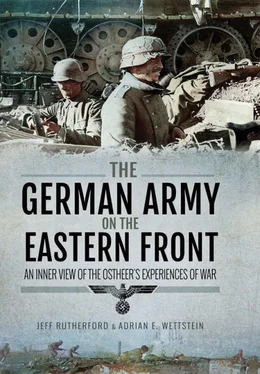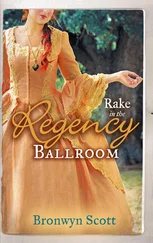In the discussion of artillery, there was a clear recognition of the Soviet artillery’s qualities, including it being more agile than German artillery, as well as having learned command techniques to concentrate more firepower. But the Germans still possessed advantages such as fire observation by plane. The competition between infantry and artillery over the command of various artillery segments also clearly emerged. While the artillery claimed superior leadership in using heavy weapons, the infantry demanded more support weapons under its command, since artillery units could not always maintain the pace of the advance and were therefore not always available when needed. This demand was made regarding the heavy infantry gun, but it was even more evident with the already mentioned heavy mortar, as can be seen in the document’s next section:
All ATGs with a calibre 5cm or bigger are in their actual form too heavy for mobile warfare in the bog forest or even for positioning in the positional war. By request of the troops, those weapons should be easy to disassemble, in order to carry them in the way of mountain artillery pieces everywhere.
The interim report already pointed to the importance of the Russian heavy 12cm mortar. The troops are extremely appreciative that the bureau copied the mortar. One can hear again and again: ‘Hopefully it will come soon in great numbers’. Infantry and artillery struggle in the same way for that weapon, which has proven always the same in attack and defence, in summer and winter.
Since we did not possess the capacities at the time, one had to reduce equally the programs for the light and heavy field howitzer. Today, every division prefers to take 4 heavy mortars instead of one light field howitzer, 6 mortars instead of one heavy field howitzer. This is one of the few points in which the requests of the troops conform. One should not disappoint the troops and do the utmost so that the mortar is built as fast as possible and in the highest possible number. If the troops receive 1,000 mortars, only 5 mortars are allotted to each division, and that is with a front sector often of 20-30km. Whether the infantry or the artillery will be equipped with the mortar, or if one organizes divisional mortar battalions, 3,000 mortars must be produced in 6 months, and at the cost of the light and heavy field howitzer and the light mortar, which was not used much in the winter due to the small effect of the light mortar rounds in the snow.
This demand on these grounds is especially important, since it gives the superiority of weapons back to the German infantryman, which, at the moment, is with the Russian side (semi-automatic rifles, rifles with telescopic sights). In addition it is emphasized again and again that the Russian digs-in in an unbelievably short time and can be contained only with a steep angle weapon.
From 1943 on, German units received the heavy 12cm mortar 42, an improved version of the Soviet mortar. Even more of a problem than the numbers of mortars produced was the availability of mortar shells, as enough failed to reach troops at the front. This was a consequence of the far too broad array of weapons in service and the resulting dispersion of production capacities. The report also mentioned infantry weapons:
Infantry weapons are only briefly addressed here. […] Repeated here are the most urgent demands: Equipping of the troops with an explosive cartridge […]. The troops do not understand why this cartridge is denied to them, but expect that they will be constantly shot with them by the Russians. The Russian explosive cartridge is not only morally damaging – especially in the woods! – it also causes such heavy wounds, that a full recovery from even apparently light wounds is extremely rare.
A likewise urgent demand is for rifles with telescopic sights. The infantry generally complain of bad training, especially the poor marksmanship training of the replacements. […]
The infantry men fires little with the rifle, he relies on machine and heavy weapons. It is all the more important to arm the few good marksmen with a premium weapon, namely the rifle with a telescopic sight.
A higher SS commander has ‘obtained’ 300 rifles with telescopic sights through the Reichsführer SS. In each battalion, he equipped a sniper group with those weapons. An NCO continuously promoted the training of the riflemen, their operations come out of alternating positions. Their own losses are rare, in contrast some of those men have ‘kill lists’ of 30 or more opponents.
The cry for the rifle with telescopic sight is considerably stronger than the one for the [semi-] automatic rifle. This may be explained by the fact that the Russian semi-automatic rifle often fails in deep temperatures, and many an infantryman discarded his captured semi-automatic rifle in wintertime and again snatched up the German infantry rifle. In contrast, the Russian sight [on a normal rifle] has given [German soldiers] good experiences. […] Our sight may have proven its worth over 150 years and in many wars – the Russian one is superior. […] A rifleman is unquestionably easier and faster to train with the Russian sight than with the German one […] In a comparison shooting in which soldiers of all grades participated, good results were achieved with the Russian rifle, despite the fact that all riflemen were trained with the German and not the Russian rifle. One should order a replacement battalion to train 100 recruits with both sights and then execute a comparison shooting.
The shortcomings of the German submachine gun and the superiority of the Russian one in some areas is also pointed out here […]. It is generally complained that our submachine gun is more delicate than the robust Russian one; it continuously needs careful maintenance to remain ready for action. In addition, its low safety is accentuated again and again. The number of deadly accidents – officers alone – is frighteningly high. […]
What can be said for the Russian submachine gun in terms of primitive construction in contrast to the German one also applies to other Russian weapons. For example, the Russian tank rifle is according to German standards ‘thrown together’. One agency used the expression ‘Woolworth goods’. But this W[oolworth] good is easy to produce, easy to use, needs little care, is immune to temperature, fires as well as the German one and frequently has a longer life. The troops themselves say: ‘Each individual weapon of ours is a piece of good German handicraft work, but the Russian weapons are real mass-produced goods’.
This comparison does not apply for all weapons; anyway it gives food for thought. Since the weapon is in any case not kept very long due to the wearing out of weapons in the front line (i.e. MG) through enemy fire, defective care, a considerable lack of spare parts, our manufacturing engineers could probably adopt many Russian principles. This is also a demand that the Führer and the deceased Reichsminister Todt made again and again. The machine gun 42 constitutes a step forward in the identified direction.
An additional new experience for the German infantrymen in the fight against the Red Army was their inferiority in infantry weapons. While the main German rifle, the 98k, was not significantly better or worse than the Polish, British or French equivalent, the Germans had advantages in submachine and machine guns. The Red Army confronted the German with a technically comparable rifle, but one that required less training to use effectively, with a more reliable submachine gun that possessed more firepower due to its drum magazine, and with reliable semi-automatic rifles and rifles with telescopic sights in large numbers. The important advantage in machine guns rested with the German MG 34 and was expanded by the MG 42 with its higher rate of fire and limited maintenance needs.
Читать дальше






![John Stieber - Against the Odds - Survival on the Russian Front 1944-1945 [2nd Edition]](/books/405234/john-stieber-against-the-odds-survival-on-the-russian-front-1944-1945-2nd-edition-thumb.webp)





